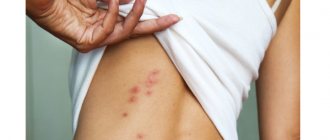Among the flies common in Russia, the blood-sucking species is the autumn flies. You can recognize it by its wide and long wings, gray color with splashes. Blood-sucking flies also include the southern and small cow flies. They choose only farm animals as targets of attack. Insects form natural and synanthropic populations, that is, they live both in natural conditions and indoors and on farms.
Autumn flies attack people, livestock and dogs in search of food. Unlike other blood-sucking insects, not only females, but also males attack humans. A fly bite is accompanied by painful sensations and severe irritation of the skin.
Of particular danger are flies that carry pathogens of various diseases: wet equine fever virus, vesicular stomatitis of livestock and horses, bovine leukemia virus, anaplasma. The autumn fly is a mechanical carrier of salmonellosis, anthrax and brucellosis.
More than 120 families of flies are found on Earth, among which there are deadly and harmless individuals. In Russia, the maximum harm from these insects can lead to allergies in hypersensitive people and to a significant decrease in agricultural productivity in livestock.
Tsetse flies, which live only in African countries, are deadly to humans. They carry trypanosomes, which parasitize the body of humans and animals, having a destructive effect on all organs and systems of the body. The victim's immunity gradually weakens, tumors develop, and the functioning of the nervous system is disrupted.
Danger from proximity to flies
In addition to being repulsive, these insects can cause health problems. The harm caused to a person depends on the lifestyle of a particular species or method of subsistence.
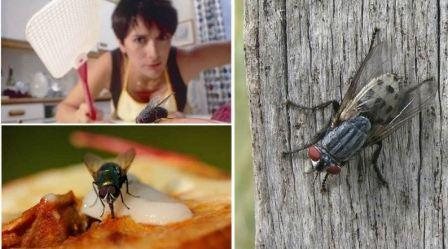
Main types of hazards from flies:
- spread of infectious intestinal diseases - flying from feces, animal corpses, garbage bins to human food, flies carry on their bodies the causative agents of cholera, dysentery, toxic infection, typhoid fever, eggs and larvae of various helminths. They also contaminate food products with their own feces and belching;
- infection with eye infections (trachoma, conjunctivitis) - by eating secretions from the eyes of a sick creature and annoying a healthy one, they infect it;
- By biting, flies eat blood, sweat, mucus secreted by the human body, thereby contributing to the formation of wounds that hurt, itch or become very inflamed;
- transmission of polio, tularemia, tuberculosis, anthrax, myiases of tissues or cavities, adenoviral, staphylococcal infections;
- food spoilage;
- nuisance plus infection of domestic animals;
- other.
Small, but ever-penetrating, fast-flying parasites can become a real disaster, because the speed of their reproduction is amazing, as is the ability to cover tens of kilometers in a day, landing on everything.
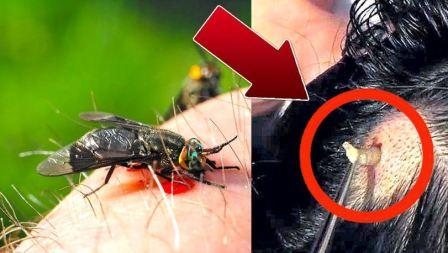
Biting flies - let's get to know each other better
Among the buzzing dipterans, the most disgusting are those that bite painfully, since one insect is enough to prevent an entire family from sleeping and living normally.
Autumn fireweed (family Stomoxys calcitrans)
This insect prefers to live near humans and domestic animals. But there are known cases when he chooses places where birds or animals gather in the wild - the main thing is a large number of “breadwinners” plus suitable conditions. You can see it everywhere, only the northern regions do not like it.
Outwardly it resembles a domestic specimen, but smaller (up to 8 mm) and grayer. Once in human habitation, it displaces ordinary, non-biting insects. Active only during the day.
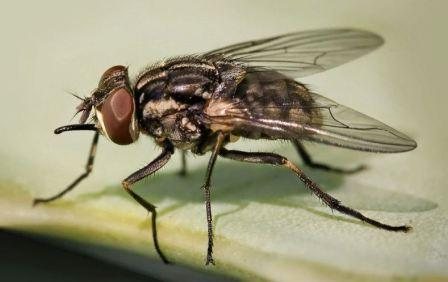
Males and females need blood for food. These insects develop up to 1.5 months. During the season they can lay up to five thousand eggs, in portions of up to 20 pieces. For masonry they choose manure, various rotten things, but they can choose the wounds of warm-blooded animals, even humans.
Despite the fact that these small buzzers have been near humans since early spring, they are noticed closer to autumn. They then begin to hysterically chew everything that gets in their way. In summer they feed on the blood of animals.
Variegated flies try to drink as much blood as possible, because there is a long, hungry winter ahead, during which they will sleep - they need to have time to stock up on useful substances, plus find favorable places for eggs. They are attracted by the warmth of human spaces and mouth-watering aromas. And once they get into closed human houses, they begin to sting everyone who gets in their way.
Important! Livers sting from August to November, depending on the ambient temperature.
When biting, the fly rubs its proboscis with teeth against the skin of a person, tears off the thinnest layer of skin, sucks blood, releases saliva with toxic components into it, which causes such irritation.
Compounds contained in saliva prevent blood clotting, making it easier for bloodsuckers to feed. Ordinary flies have “sponges” at the tip of their proboscis, while this species has sharp chitinous scrapers. They bite without preparation, instantly.
Signs of a burner bite:
- piercing point pain;
- severe itching;
- dizziness, loss of coordination, weakness;
- swelling;
- redness, swelling;
- trace with a blood spot.
Important! Allergy sufferers should pay special attention - such a bite can cause an attack.
Symptoms of the bite disappear on their own over time.
Pet protection
In most cases, flies bite animals, not only cattle, but also some pets. For example, flies can gnaw on a dog's ears, often very actively, and the owners do not know what to do to help their pet. Protecting your pet is quite simple. Some owners prefer to use folk remedies, in particular grease. It has a strong repulsive odor and creates a protective oil film on the skin, which prevents the attack of flies and other insects. At night, solid oil can be washed off with regular toilet soap and, if necessary, renewed in the morning.
Special factory-made sprays designed to repel blood-sucking insects come to the aid of dog lovers. There are several products that are suitable not only for cattle, but also for dogs and even cats. Among them:
- "Flycide." Repellent spray containing the substance diethyltoluamide. Its effect is enhanced by camphor and menthol. It is used externally and provides a comfortable stay in nature, during hunting and walking in the forest, as well as in swampy areas. But if the animal gets wet in the rain or swims in a pond, the effect of the drug stops.
Important! Read the instructions carefully and follow the application rules. Please note the side effects: “Mukhotsid” can provoke an allergic reaction, urticaria, erythema and dermatitis, so it is highly undesirable to use it for dogs sensitive to the components of this product!
What else can you use to treat your dog against flies? As practice shows, “OFF” ointment brings excellent results in the fight against flying predators. Only to protect against flies, it is advisable to use a product not against mosquitoes, but against horseflies and midges. The ointment is applied in an even thin layer to the skin, avoiding wounds and other problem areas. In addition, the “OFF” line of drugs also includes a spray. If desired, you can use it, but only be careful not to get it on the mucous membranes of the animal’s eyes.
And remember that if your dog is bitten by flies, you should immediately look for a remedy for them. Often, insects cause very serious problems, gnawing off the tips of the ears so much that these wounds have to be treated in a veterinary clinic.
Bloodsucking, family Hippoboscidae
All representatives of this family are similar: a flat body, jagged legs widely spaced. Adults suck blood from humans or animals. They immediately give birth to live flies.
Deer bloodsucker (Lipoptena servi L)
A tiny insect, very aggressive, “evil”. It prefers large warm-blooded animals, for which it is also called the moose louse, but it does not disdain humans. Lives in forests, tundra, steppe zone.
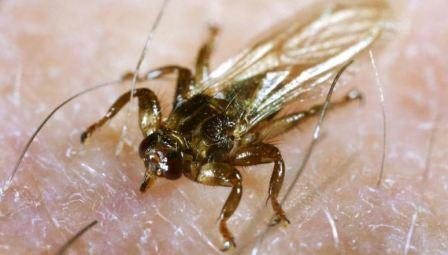
The bites are painful and irritate the skin. One bite is enough for blood to flow from the wound, the temperature to rise and body aches to begin. In addition to physical discomfort, this tick-like little thing spreads Lyme disease and many others. Its durable shell and special body structure make it indestructible - it is almost impossible to crush it with your fingers.
Horse and dog bloodsucker (Hippobosca equina L., Hippoboska longipennis L. = Hippoboska capensis Olf)
Small, annoying, biting flies that prefer wooly warm-blooded animals, but they will definitely bite a person if he passes by. They often live close to people.
Why is the bite of this insect dangerous?
The tsetse fly feeds mainly on the blood of various animals - both wild and livestock, but often attacks humans in search of food, which leads to very serious consequences. The fact is that flies infect the blood with trypanosome parasites, the presence of which in the body causes the deadly disease trypanosomiasis, or sleeping sickness . With this diagnosis, a person can die within a few months.
Once the trypanosome parasite enters the human body, it has a gradual destructive effect. First it destroys the immune system, then the central nervous system. The lymph nodes become inflamed and the throat becomes completely swollen. The whole human body is covered
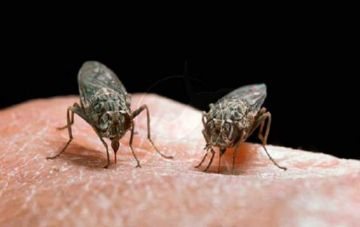
painful tumors. The disease is accompanied by headaches, drowsy and apathetic state, fever, weakness, lack of appetite, which, in turn, can lead to complete exhaustion and even coma.
Through the tsetse fly, the parasite that causes a deadly disease reaches humans and other animals from the antelope. The body of antelopes is immune to trypanosomes, so infection does not affect the health of these animals in any way. But when they enter the human blood, trypanosomes change their protein shells, forming thousands of different forms. Therefore, one medicine cannot cope with so many opponents.
Horseflies or spiders
This group includes 3 dozen species of blood-sucking flies. They sting incredibly painfully and attack travelers aggressively, surrounding the person in a cloud. There are commonly encountered species, and there are more rare ones.
Red-whiskered horsefly or blinding lacewing (Chrysopsinae)
A large fly, almost 3 cm, we prefer areas near water bodies. Only females bite, sucking 0.2 ml at a time. They need biological fluid to lay eggs. Males have enough nectar from flowers.
The bullfly is 2 times larger than the previous biter.
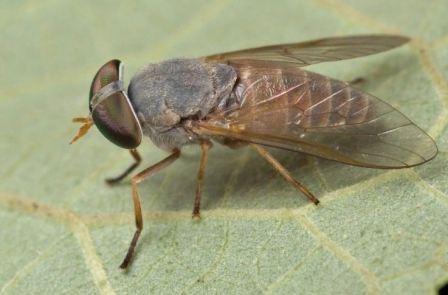
“Sailor”, or deer horsefly, is small, striped, very vicious, bothering animals and people.
Horseflies find victims hundreds of meters away and flock together to feast. If people are driving in a car, then insects will fly into the open window, even if the car is moving 70 km/h! By attacking the driver, the pest can even provoke an accident. It will land on your face and other open areas, continuously stinging. And if you stop, then hundreds of flying flies cannot be driven out of the cabin or crushed.
Important! Horseflies prefer black. This should be taken into account when choosing an outfit for a walk. They attack anything black, and if they fail to bite, they will leave a continuous layer of sticky excrement.
Healthy. It is better not to crush insects, as they will squirt viscous contents. It is better to tear off the head of the bloodsucker and give the dead insect to the ants for food.
Natural enemies regulate the size of natural populations.
Natural enemies of horse flies:
- birds that eat insects;
- predatory insects larger than horseflies (dragonflies);
- spiders that weave strong webs.
But they cannot destroy them, so travelers or farm owners will have to save themselves and their animals from the attacks of these flying vampires. Horses, cows or deer have only two ways to defend themselves: the tail or branches of bushes or trees. Therefore, pets should be protected using repellents.
Gadflies
Cute insects with a thick belly and fluffy abdomen are among the most dangerous to humans. There are species that resemble bumblebees or bees. The absence of a mouth does not make it helpless - they plant their brood in the body of the victim.
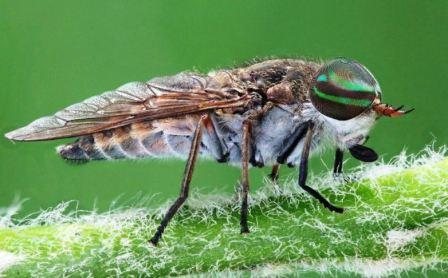
Although these insects do not even have a mouth, they also make an injection to lay their eggs under the skin of a warm-blooded animal. These parasites do not remain in the adult stage for long; the period is just enough to find a host and breadwinner for the future offspring. During treatment, you will have to remove the clutch of eggs by cutting off part of the skin or even muscles.
Gadflies of all types prefer to live in pastures. Their larvae are born, grow and feed in the body of an animal or human.
Stomach gadflies target horses, donkeys and people.
Representatives of the family Gasterophilidae are distributed everywhere, choosing the hairy part of the body or grass on which animals feed. This is how the larvae enter the body, the digestive tract. And as they mature, they come out through the skin or with feces.
If the eggs are laid on the skin, the larvae make painful and itchy tunnels throughout the body for almost 3 months. If the stomach is chewed out, the victim develops catarrhs.
Subcutaneous gadflies are known for gluing individual eggs to the hairs of the victim.
Newborn Hypodermatidae larvae crawl through the host's body, causing myiasis. Then they crawl out through the skin. In addition to creepy holes, holes on the body of the parasite carrier, there are cases when the larvae entered the victim’s brain, causing death.
Cavity flies attack sheep, goats or horses and donkeys.
There are many species that prefer certain prey animals. Representatives of the Oestridae family infect the selected animal in flight - they splash the larvae into the eyes, nostrils, then they live in the mucous membrane or right inside the eye. Growing, they move into the cavities of the head (sinuses, pharynx), causing myiasis.
First aid
Multiple injuries are the most painful: if a fly bites the legs, arms, stomach and other parts of the body, inflammation develops.
The bite causes soft tissues to swell and overall health may deteriorate. The wounds of the bitten person are treated with an antiseptic - brilliant green, alcohol, iodine. What to apply to bites on babies? In this case, non-alcoholic products will help - chlorhexidine, hydrogen peroxide. Also, when bitten, soothing and cooling ointments help, which reduces the manifestations of local reactions. To prevent fly bites from causing allergies in children, they give Zodak drops or Diazolin for children.
Ant bite
Tsetse fly
When getting acquainted with biting or blood-sucking flies, do not forget about the formidable African insect that carries sleeping sickness. Although the tsetse fly is not found in our country, it is still a formidable enemy of humans, since the disease is incurable.
Faded color, size up to 18 mm, long protruding proboscis plus wings that overlap each other when folded. Over the course of a year, tens of thousands of Africans and guests of the continent die from its bites.
Reasons why flies bite closer to autumn:
- due to the growing population, food becomes scarce;
- due to cold weather, food becomes scarce;
- More blood is needed before wintering and laying eggs.

Liver habitats
Predatory flies live mainly on farms and pastures, where they bite cows, bulls and horses, since it is their blood that forms the basis of the diet. Farmers are trying their best, but due to the high reproduction rate, swarms of carnivorous flies are not decreasing.
On a note! The zhigalka fly is very prolific and can reproduce four generations of offspring over the summer!
Females lay their clutches in compost and manure heaps, where the heat from rotting helps the hatched larvae to develop successfully. The young emerge from the egg in about 5 days, after 2-4 weeks the larvae turn into pupae, from which new flies appear after another 1-4 weeks. And after 10 days, the young animals emerging from the pupae are completely ready for reproduction.
By the beginning of autumn, there are especially many burner flies, so some of them fly away from farms and pastures in search of new food sources. In addition, the gradual cooling forces them to look for warm shelters in which they can safely survive the approaching night frosts. As a result, they end up in residential buildings, where they attack people. This is why flies bite in the fall.
Features of the bite
As mentioned above, in biology and morphology, the zhigalka fly is very similar to a housefly: the body length is about 6-7 mm, the integument is gray, there are dark stripes on the chest, and dark gray spots on the abdomen. The main difference is the oral apparatus, which in predators is represented by a highly elongated proboscis. At the end of this organ there are hard chitinous plates curved backwards. The fly rubs them against the skin of its victim, scrapes off the layer of epidermis and feeds on blood. At the same time, she injects a poisonous secretion, which leads to irritation. Because of this, the fly bite is quite painful.
Plus, jug flies are carriers of pathogens of many diseases, among the most dangerous:
- pathogens of staphylococcal infection;
- anthrax;
- tularemia;
- sepsis.
Moreover, some diseases are zoonotic - common to animals and humans.
Means of control and prevention
To defeat small, fast, voracious insects that exceed the prey in quantity and speed, a number of measures should be taken:
- Airtightness of the room (mesh on windows, doors).
- Use of adhesive tapes, insecticides, repellents.
- Regular disinfection and use of folk remedies.
Proven folk remedies include the use of green repellers. These are wormwood, geranium, bird cherry, currant, tansy or castor bean. Plants can be planted around the house, indoors in flowerpots.
Ultrasonic repellers that are inaudible to people, wiping window frames with a vinegar solution and herbal decoctions help.

